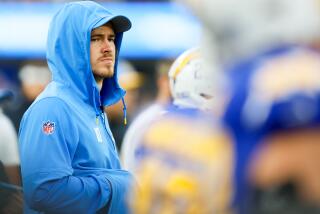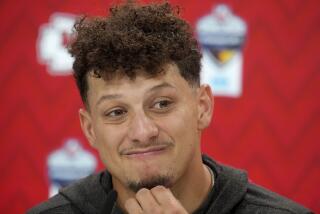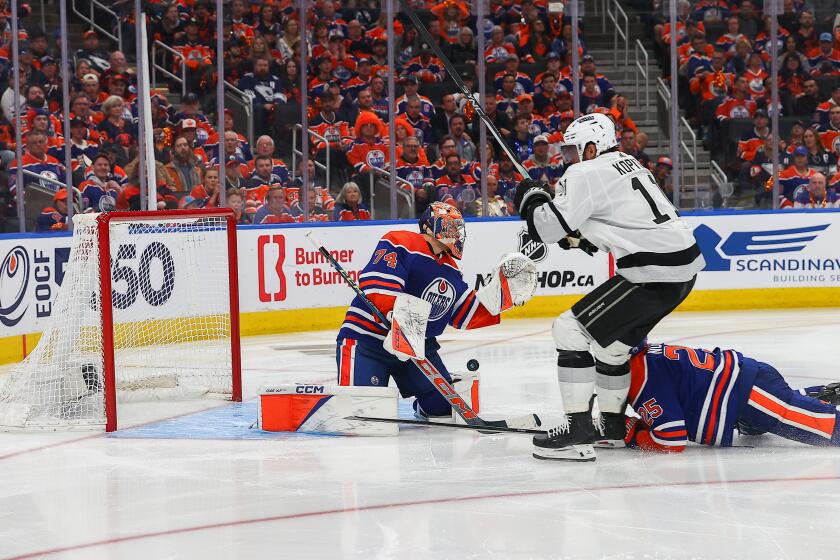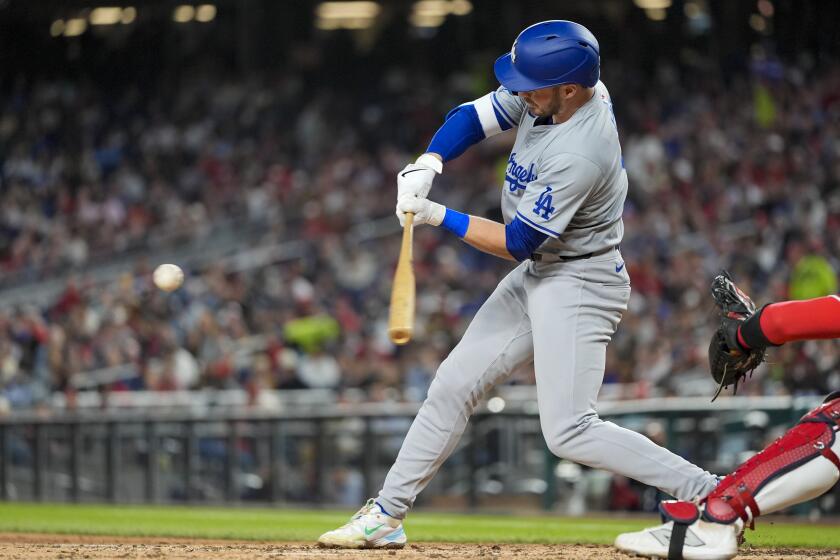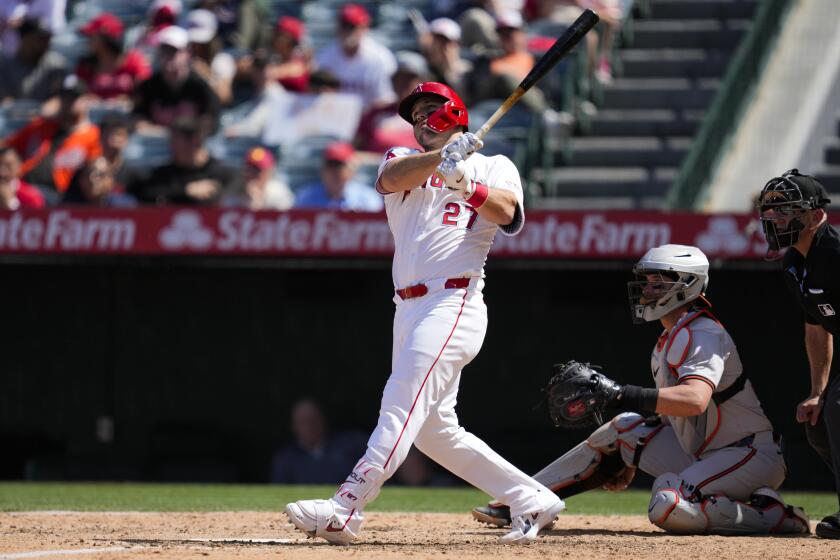Broncos QB Peyton Manning wrote the book on speed reading
Peyton Manning flaps his arms, stamps his foot and plays traffic cop, sending Denver Broncos teammates this way and that. All the while, the play clock is winding down.
Manning isn’t just playing quarterback. He’s playing chicken with the defense, baiting it to reveal strategy. His success before the snap is a reason he is counted among the greatest quarterbacks in NFL history, and it’s a tactic he will use Saturday in a divisional playoff game against Baltimore at Sports Authority Field.
“I’m betting that 90% of the time before he gets the ball, he knows where he’s going with the ball,” said Hall of Fame quarterback John Elway, the Broncos’ top football executive. “That helps with getting rid of it, and it also helps with his accuracy, because if he knows where he’s going with it, it’s a hell of a lot easier to get the feet set and get it going to the right spot.”
Manning, the league’s only four-time most valuable player, is a leading candidate to pick up his fifth award. In his first season with the Broncos, he led the NFL with a 68.6 completion percentage, was second with a 105.8 passer rating, third with 37 passing touchdowns and sixth with 4,659 passing yards.
To get as long a look at the defense as possible, Manning frequently runs a no-huddle offense. He never has to turn his back to the opposition. The Broncos have become increasingly effective in that mode, and their style of no-huddle differs from that of other NFL teams’.
For example, while the New England Patriots with Tom Brady are adept at changing tempos, shifting in and out of the no-huddle in a flash, and giving opposing defenses precious little time to make personnel changes, the Broncos tend to take their time and use the scheme so that Manning can take a long look at what he’s facing on a particular play.
“What really changed the no-huddle — and Peyton was probably the first guy to master it — was the dummy snap count,” said former NFL quarterback Trent Dilfer, now an ESPN analyst.
“It used to be, ‘Set HUT!’ and the ball was snapped. Or ‘Set HUT-HUT’ and the ball was going to be snapped. Now quarterbacks get up there in the no-huddle and go, ‘Set HUT-UT-UT!’ and it’s a dummy. And then the defense resets, you know what they’re going to do, and you go, ‘Set HUT-UT-UT!’ And it’s a dummy too. And now the defense is just sitting there in their stance, because they have to be ready for it.
“They let the quarterback read their mail. The quarterback has already opened the envelope and read the mail. Now they go, ‘OK, now that I’ve read your mail, we’re going to do A, B and C to get in the best play possible . . . ‘SET-HUT!’ and the ball is snapped.”
Colts offensive coordinator Bruce Arians, who was Manning’s first quarterbacks coach in the NFL, said the Broncos star simply outlasts an opposing defense, waiting until it no longer has time to disguise its strategy, then quickly dials into the ideal play.
“Teams defensively are getting taught so well they’ll wait till the [play] clock hits nine, some wait till eight, to leave their last disguise,” Arians said. “Then, as an offense, you have to have code words that are fast enough to get the right play and the snap count off in basically six seconds.”
That means one-word plays and hand signals that get all the offensive players on the same page.
“Peyton’s the master,” Arians said. “I don’t think too many people can do that. Brady’s doing a hell of a job with it too. They have a great hand-signal system. They can go fastbreak. It’s real good when the rest of your guys can handle it.”
In the NFL, an offense has 40 seconds from the end of a given play to get the ball snapped on the next play, or 25 seconds after the ball is spotted after an administrative stoppage such as a penalty, timeout or end of a quarter. Manning tries to vary the pace of the offense, although he seldom goes at the full-throttle speed that Brady uses with the Patriots.
“The key is how fast you’re going,” Manning said. “Some teams go no-huddle, but it’s simply not huddling, it’s not really fast-paced. I think you want to constantly look at that. The faster we go, the better we can be.
“And the more we see how people play us, how they defend us in certain situations, how they react to things we do, the better it will be, the better we can prepare for how we want to handle things.”
There’s a more patient, cerebral feel to the no-huddle now than there was two decades ago, when Jim Kelly was running the fast-paced “K-Gun” offense for the Buffalo Bills.
“We did it because that’s the pace we felt comfortable with, and also it tired the defensive linemen out,” Kelly recalled. “Our offensive linemen were in such great shape that there were times if I would slow the pace down some, [center] Kent Hull would say, ‘Come on, man, pick it up! Pick it up!’
“We didn’t want those big guys on the other side to get an extra breath, or be able to continue to substitute back and forth. There wasn’t a lot of disguising coverages, because defenses really didn’t have time to do that.”
There were times, Kelly said, when defenses actually would beg the Bills to take their foot off the gas.
“Ask Howie Long about that,” he said, referring to the great Raiders defensive lineman. “I remember we played them in the AFC championship game [in 1991] and he yelled at me. He was like, ‘Come on, Kelly! Slow this down, man! Slow it down!’ I just started laughing.”
As for Manning, he’s more of a patient professor.
“Peyton is a pioneer when it comes to a no-huddle that isn’t necessarily a fastbreak,” Elway said. “It’s more, let’s just get them to the line of scrimmage and make them commit.”
In some circles, Manning’s nickname is “Perfect Peyton,” and there’s no question he’s a perfectionist in most aspects of his life. But Hall of Fame coach turned broadcaster John Madden, who is close friends with Manning, said the quarterback isn’t necessarily trying to get into the perfect play when he’s at the line of scrimmage.
“His whole philosophy is to stay out of a bad play,” Madden said. “It’s not necessarily to get into the best play where you’re going to get the defense every play, obviously you’re not. He wants to get into a play that has a chance.”
From a defensive perspective, Madden said, there’s no surefire way to beat Manning.
“There’s no answer to a great quarterback,” he said. “There’s no, do you blitz them or not, do you zone them or not, do you press him? The only thing you can do with him is disguise, and keep him from knowing what you’re doing as long as you can.
“But eventually, you’re going to do it and he’s going to see it. Whatever you’re doing to disguise, you’d better change because he’s going to figure you out.”
Twitter: @LATimesfarmer
More to Read
Get our high school sports newsletter
Prep Rally is devoted to the SoCal high school sports experience, bringing you scores, stories and a behind-the-scenes look at what makes prep sports so popular.
You may occasionally receive promotional content from the Los Angeles Times.
